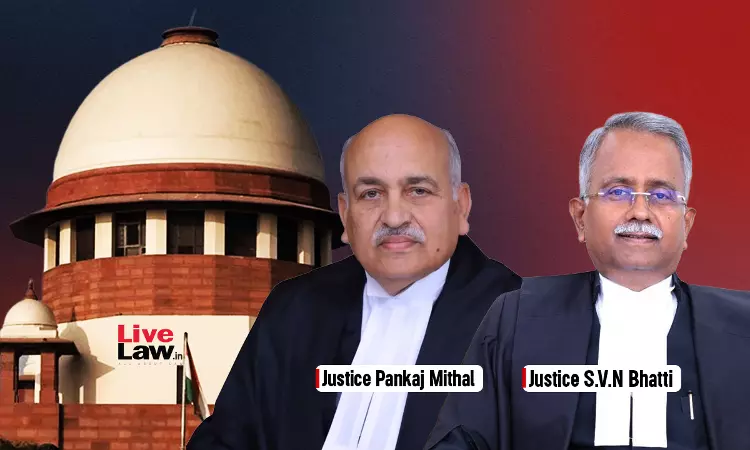- Home
- /
- Supreme court
- /
- When Can Relief Be Moulded In A...
When Can Relief Be Moulded In A Suit? Supreme Court Explains
Yash Mittal
26 March 2025 11:13 AM
The Supreme Court stated that if the relief sought in a suit cannot be granted, or if granting an alternative relief can expedite litigation, the Court has the authority to "mould the relief" instead of dismissing the suit.“The concept of moulding of relief refers to the ability of a court to modify or shape a relief sought by a party in a legal proceeding based on the circumstances of the...
The Supreme Court stated that if the relief sought in a suit cannot be granted, or if granting an alternative relief can expedite litigation, the Court has the authority to "mould the relief" instead of dismissing the suit.
“The concept of moulding of relief refers to the ability of a court to modify or shape a relief sought by a party in a legal proceeding based on the circumstances of the case and the facts established after a full-fledged trial. The principle enables the court to grant appropriate remedies even if the relief requested in the pleading is not exact or could not be considered by the court or changed circumstances have rendered the relief obsolete. The court aims that justice is served while taking into account the evolving nature of a case. The above road map is pursued by a court based on the notion of flexibility in relief, equitable jurisdiction, and is tempered by judicial discretion.”, the court observed.
The bench comprising Justices Pankaj Mithal and SVN Bhatti heard the case where the dispute involved the ownership of a property (Plaint Schedule) originally purchased by one Padmini Chandrasekaran in a court auction (1962). She later bequeathed it via a Will (1975) to Vinayagamurthy and his children, administered by a Trust.
Interestingly, one Somasundaram Chettiar also executed a Will bequeathing the same property to his adopted son (Defendant No. 1, Sarvothaman).
The dispute arose when Defendant No.1 sold the property to Defendants 3–6 (appellants), despite Padmini's prior ownership.
Thereafter, the Trust filed a suit on the original side of the Madras High Court seeking to declare void the sale deeds executed by Defendant No. 1 (Sarvothaman) of the suit property in favor of Defendants 3–6 (1992), claiming they had no title. Moreover, the Trust claimed the possession of the property bequeathed via a Will by Padmini to Vinayagamurthy and his children.
The Single Bench and Division Bench granted a relief to the trust to declare the sale deed as void, but instead of providing a possession to the Trust it moulded the relief in favor of one of the executors of the Will i.e., HBN Shetty for the benefit of Vinayagamurthy and his children because the plaintiff-trust was not able to prove its title as the Will was bequeathed to Vinayagamurthy and his children, and not the trust.
Aggrieved by the High Court's decision to set aside the sale deed, the Appellant appealed to the Supreme Court
Upholding the challenged decisions, the judgment authored by Justice Bhatti observed that the High Court was justified in moulding the relief to ensure substantive justice for Vinayagamurthy and his children, thereby giving effect to Padmini's Will. Rather than dismissing the suit, the Courts below were justified in granting a relief to the executor, Dr. H.B.N. Shetty, allowing the sale deeds to be set aside and the Will's terms to be enforced.
The court applied the principle of moulding of relief by rejecting the Trust's request for possession, as it had no claim over the Plaint Schedule. Noting that HBN Shetty was both a trustee and executor of Padmini's Will, the court set aside the invalid sale deed instead of requiring Shetty to file a separate suit. This ensured the Will's enforcement without unnecessary litigation.
The High Court's observation applying the doctrine of moulding of relief in HBN Shetty's favor, being approved by the Supreme Court states:
“Simply because H.B. N. Shetty, who happened to be the trustee of the plaintiff trust, filing the suit, is it necessary for him to file another suit in order to get a decree for setting aside the sale of defendants 3 to 6 of suit property and in order to oblige the terms of the Will of the testatrix, who was found as a real owner of the property. In my opinion, especially in the present facts and circumstances of the case, it is unnecessary to make him to go in for another suit, after a lapse of 8 years. After all H.B.N. Shetty, the executor himself is very aged (more than 80 years). As some of the. executors passed away and some resigned and when H.B.N. Shetty himself is very old, it may not be desirable to make him or other executor to file another suit. If the law permits, then the suit can be decreed in favour of H.B.N. Shetty in his different capacity as executor of the Will of Padmini, the real owner.”
In this regard, the Court cited the case of Shivanna vs B.S.Puttamadaiah (Dead) Through Lrs. (2023) SCC OnLine SC 1969 where the conditions required to be satisfied before applying the principle of 'moulding of relief' was laid down. The Court observed:
“The ordinary rule of civil law is that the rights of the parties stand crystallised on the date of the institution of the suit and, therefore, the decree in a suit should accord with the rights of the parties as they stood at the commencement of the lis. However, the Court has power to take note of subsequent events and mould the relief accordingly subject to the following conditions being satisfied:
(i) that the relief, as claimed originally has, by reason of subsequent events, become inappropriate or cannot be granted;
(ii) that taking note of such subsequent event or changed circumstances would shorten litigation and enable complete justice being done to the parties; and
(iii) that such subsequent event is brought to the notice of the court promptly and in accordance with the rules of procedural law so that the opposite party is not taken by surprise.”
Applying Shivanna's case to the facts of the present case, the Court noted that it would not be in the interest of justice to make the executor-HBN Shetty (80 years) to file another suit to oblige the terms of the Will of the testatrix, who was found as a real owner of the property. Therefore, instead of asking him to file an another suit, the Court noted that the High Court was justified in moulding the relief in favor of the executor so that the fruits of the Will could be reaped by the beneficiary- Vinayagamurthy and his children.
“We may hasten to add that the court of first instance, while exercising the discretion to mould the relief, juxtaposes the consideration with the established conditions of the original relief becoming inappropriate or shortening the litigation and enabling rendering complete justice between the parties. The scrutiny on the moulding of relief by the appellate court tests the exercise of discretion by the trial court, but not in all cases, sit in the very armchair of the court which moulded the relief and re-examine every detail unless prejudice and grave injustice are pointed out against the moulding of relief. In a further appeal on the moulding of relief, the examination by the second appellate court ought to be minimal and not unsettle the settled. In our considered view, the moulding of relief, in this case, is to shorten the litigation and not subject the Plaint Schedule to vagaries of certain and uncertain documents. We are in complete agreement with the findings recorded by the impugned judgements.”, the Court observed.
Accordingly, the Appeal was dismissed with a cost of Rs. 1,00,000/- (Rupees one lakh only) payable to the Legal Aid Services Authority of the Madras High Court within four weeks from the date of judgment.
Case Title: J. GANAPATHA AND OTHERS VERSUS M/S. N. SELVARAJALOU CHETTY TRUST REP. BY ITS TRUSTEES AND OTHERS
Citation : 2025 LiveLaw (SC) 353
Click here to read/download the judgment
Appearances:
For Petitioner(s) :Mr. R Basant, Sr. Adv.(argued by) Mr. M. A. Chinnasamy, AOR Mr. C Raghavendren, Adv. Mrs. C Rubavathi, Adv. Mr. Ch.leela Sarveswar, Adv. Mr. V Senthil Kumar, Adv.
For Respondent(s): R-1: Mr. Dama Seshadri Naidu, Sr. Adv.(argued by) Mr. V. Balaji, Adv. Ms. V. Pushpa, Adv. Mr. B. Dhananjay, Adv. Mr. Asaithambi Msm, Adv. Mr. Vinod K. Nair, Adv. Mr. Rakesh K. Sharma, AOR
R-2: Mr. Jayanth Muth Raj, Sr. Adv.(argued by) Mr. Vadivelu Deenadayalan, AOR Mr. Ashwin Kumar D.S., Adv. Mr. Ishan Roy Chowdhury, Adv.
R-5-6 Mr. P B Suresh, Sr. Adv.(argued by) Mr. Nikilesh Ramachandran, AOR Mr. Shubham Seth, Adv. Ms. Prakruti Malhotra, Adv. Mr. Rajneesh Gedamz, Adv.

